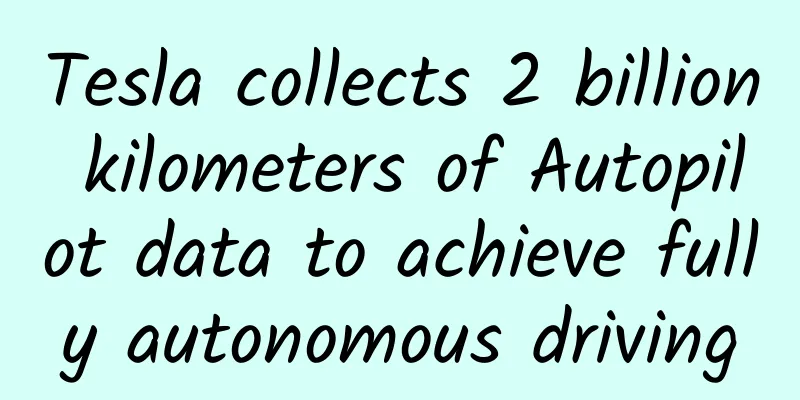Tesla collects 2 billion kilometers of Autopilot data to achieve fully autonomous driving

|
Recently, according to foreign media reports, as Tesla's new models will soon complete assembly at the Fremont factory in the United States, the company will also begin to transition from its first-generation Autopilot hardware to its second-generation hardware, in order to gradually achieve Level 3 and Level 4 autonomous driving functions, and ultimately achieve fully autonomous driving functions. As discussed in the past, the automotive industry has questioned whether Tesla can achieve Level 5 self-driving cars with its new Autopilot hardware. However, there is one reason Tesla is confident that it can develop fully self-driving cars, and that reason is data. Technology website Electrek has learned that Tesla has now collected 1.3 billion miles (about 2 billion kilometers) of data from its first-generation Autopilot hardware suite, and almost all of that data is useful for the second-generation Autopilot. Last month, Electrek reported that Tesla's fleet had accumulated 3 billion miles (about 4.8 billion kilometers), and last week Tesla confirmed to Electrek that 1.3 billion of those miles were driven by Tesla cars equipped with Autopilot hardware. More precisely, these 1.3 billion miles were not driven using the Autopilot feature, but only by Tesla cars equipped with the first generation of Autopilot hardware. Even if the car does not activate Autopilot, Tesla can still collect driving data to enhance the machine learning system and improve the Autopilot project: Autopilot, Enhanced Autopilot, and Full Self-Driving. At present, the actual mileage driven by the Autopilot feature is close to 300 million miles (about 480 million kilometers). Compared to May 2016, when Tesla announced that it had collected a total of 780 million miles (about 1.2 billion kilometers) of driving data from cars equipped with Autopilot hardware, of which nearly 100 million miles (about 160 million kilometers) were driven through the Autopilot feature. It is reported that in less than six months, the total mileage collected by Tesla for cars equipped with Autopilot hardware has increased by more than 60%, and the number of miles driven through the Autopilot function is about three times the previous data. At the same time as the demonstration above, Sterling Anderson, director of Tesla's Autopilot project, described to the outside world how Tesla will use Autopilot hardware in its development process when Autopilot is not activated. The fleet of vehicles equipped with the first generation of Autopilot has now grown rapidly to more than 100,000 vehicles, and while Tesla is currently transitioning to its second-generation Autopilot hardware, the development process is largely the same. As previously reported by tech website Electrek, Tesla currently collects more autonomous miles in a day than Google has logged since the program was established in 2009. However, the data sets collected by the two companies are very different. Tesla's sensor suite is reportedly not as accurate as Google's, but the company is making corresponding improvements to its second-generation sensors to make them more user-friendly. As of the end of October 2016, Google has collected nearly 3.5 million miles (5 million kilometers) of data (2.2 million miles of autonomous driving data and 1.3 million miles of manual driving data), and Google's fleet of just over 50 cars can add nearly 25,000 miles (about 40,000 kilometers) of driving data per week. Tesla, on the other hand, currently collects millions of miles of driving data per day from its first-generation Autopilot. However, with the 360-degree cameras currently being developed by the Tesla Vision project, a wider range of visual information, more advanced ultrasonics, and Tesla's new radar technology, the second-generation Autopilot - which aims to achieve full self-driving capabilities like Google's cars - should catch up to the first generation's data collection in the second half of 2017. To be fair, while Google does not have a large fleet of vehicles to collect data similar to Tesla's, the company is adding 3 million miles (about 4.8 million kilometers) of simulated data every day in its labs. Tesla CEO Elon Musk has previously mentioned that Tesla and other companies developing autonomous driving systems will need billions of miles of data support to convince regulators that the system is safe and reliable. Tesla seems to be progressing well, but it still needs to orbit the earth or go to Mars several times to meet the system needs. As a winner of Toutiao's Qingyun Plan and Baijiahao's Bai+ Plan, the 2019 Baidu Digital Author of the Year, the Baijiahao's Most Popular Author in the Technology Field, the 2019 Sogou Technology and Culture Author, and the 2021 Baijiahao Quarterly Influential Creator, he has won many awards, including the 2013 Sohu Best Industry Media Person, the 2015 China New Media Entrepreneurship Competition Beijing Third Place, the 2015 Guangmang Experience Award, the 2015 China New Media Entrepreneurship Competition Finals Third Place, and the 2018 Baidu Dynamic Annual Powerful Celebrity. |
<<: Weakness and self-destruction: Why didn't Microsoft release a new Surface Pro?
>>: Dubai expands deployment of driverless shuttle buses
Recommend
Will the development of artificial intelligence make you unemployed?
The impact of technology on employment dynamics i...
Can I receive express delivery in Hangzhou now? Can I receive express delivery passing through Hangzhou?
A few days ago, several couriers at SF Express tr...
History of human war against epidemics丨He built more than 500 microscopes out of interest, and the "small animals" he recorded shocked the world
Malaria, smallpox, influenza...Epidemics have acc...
The boss cuts the budget drastically, is the advertising industry "dead"?
Brand advertising and performance advertising are...
#千万IP创科普# Avoid lightning! Air fryers frequently catch fire, you may have been using it wrong
Air fryer Because it is convenient and easy to us...
Sacon’s dilemma: Rapid decline in performance means there are not many cards left to play
Sacon, once ranked first in the kitchen appliance ...
Community operation: analysis of how to run an active community!
In today's world where everyone is addicted t...
The marriage with Great Wall is just an ulterior motive. BMW’s future competitor in China may be Didi Dache!
Recently, Great Wall Motors and BMW Holding (Neth...
Why does everyone dislike using the "smart voice" in their mobile phones?
As we all know, voice navigation, voice photograp...
First Prize for Primary School Student's Cancer Research Paper Revoked (Attached with Full Notice)
First prize for primary school student's canc...
Apple China makes another big move: iOS games require a license to be listed on the App Store
Recently, Apple's Chinese App Store has remov...
Birds nesting in streetlights? Is this a better or worse life?
This is a street lamp in Shenzhen Futian Mangrove...
Why do we want to rub, pinch and bite cute things?
© Tuan Tran/Getty Leviathan Press: This is indeed...
5K iMac reveals Apple's cutting-edge technology
As the first all-in-one computer with a 5K displa...
Teach you a trick to scan old photos losslessly to your phone, especially clear, and save them forever
Today I will teach you a method to scan old photo...









